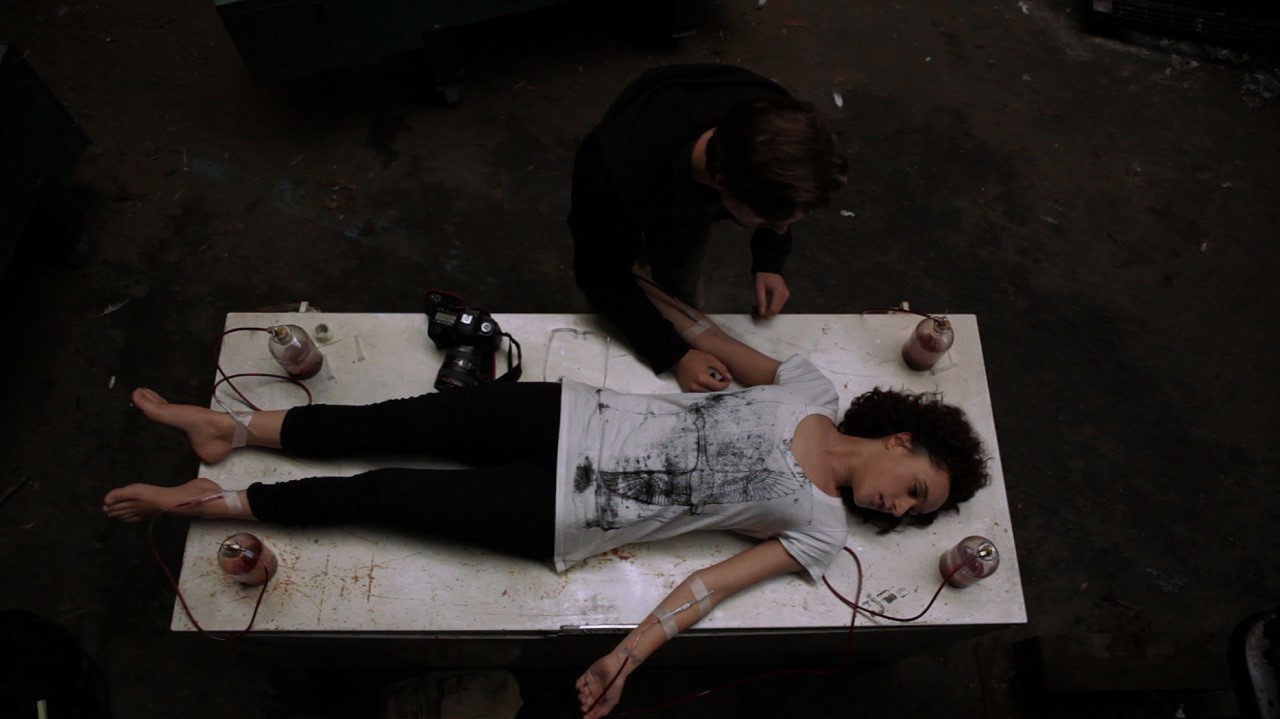Crew
Director/Screenplay/Photography/Music – Shunji Iwai, Producers – Tim Kwok & Shunji Iwai, Visual Effects – Monster Film Partners, Special Effects Supervisor – Brian McIlroy, Production Design – Alexandra Rojek. Production Company – Rockwell Eyes/Convergence Entertainment.
Cast
Kevin Zegers (Simon Williams), Rachael Leigh Cook (Laura King), Adelaide Clemens (Ladybird/Ingrid Bell), Amanda Plummer (Helga Williams), Trevor Morgan (Renfield), Keisha Castle-Hughes (Jellyfish), Aoi Yu (Mina), Kristin Kreuk (Maria Lucas), Kyle Cameron (Abbot King), Jodi Balfour (Michaela), Katherine Isabelle (Lapis Lazuli)
Plot
Simon Williams is a high school biology teacher in Seattle who tends an Alzheimer’s ridden mother. He frequents suicide support chat rooms and meets up with young women to join in mutual pacts to end their lives. He in fact has no interest in committing suicide himself but instead uses the opportunity to persuade the girls to let him drain their blood. He then uses this to feed his fetish for drinking blood. His activities gain him the nickname The Vampire in the media.
Japanese director Shunji Iwai (or Iwai Shunji as he prefers to be listed here as per the Japanese custom of placing the surname first) is a new name to me. He has however made some twenty films since 1991, including titles such as Love Letter/Close My Eyes (1995), Picnic (1996), Swallowtail Butterfly (1996), All About Lily Chou-Chou (2001) and Hana & Alice (2004), although nothing else that ventures into genre material. Iwai is a quintuple threat, not only directing, writing and producing his films but also acting as cinematographer and composing the scores. Vampire was Shunji Iwai’s first English-language film, which he shot in the US using an American cast and a number of familiar faces (although often in unglamorous and different roles than we are used to seeing them). Subsequent to this, Iwai made other genre films such as the animated The Murder of Hana and Alice (2015) and A Bride for Rip Van Winkle (2016) and the peculiarly charming low-fi Covid film The 12 Day Tale of the Monster that Died in 8 (2020).
It is best to clarify one thing at the outset – Vampire is not a Vampire Film. At least in the classic supernatural sense with capes, fangs or undead with an aversion of crucifixes, garlic, daylight etc. It does have one scene that features a sub-culture of people who believe they are (or at least try to enact behaving like vampires). The central figure of the film, the mild-mannered schoolteacher played by Kevin Zegers, is a serial killer (of sorts) who is nicknamed The Vampire in the press and has a fetish for draining the blood of women and then drinking it. In this sense, the film that Vampire most resembles is George Romero’s extraordinary Martin (1976), which contrasted a young man with a sexual fetish for blood-drinking with a superstitious grandfather who insisted that he was a vampire in the traditional sense.
Vampire could be Martin without the element of ambiguity, as merely a film that is observing a man with a pathological condition. In terms of Kevin Zegers’ m.o. – wherein he chooses women from suicide support chat rooms, befriends them then persuades them to let him drain their blood – the character’s low-key, friendly manner resembles Owen Wilson’s kind, caring serial killer from The Minus Man (1999). Vampire does at least pay homage to the classic vampire and includes references to Bram Stoker’s Dracula (1897) with characters named Mina, Renfield and Lucy, as well as a Polidori after John Polidori who wrote one of the earliest vampire stories The Vampire (1819).

Shunji Iwai creates an amazing film with Vampire. He shoots with plain, unaffected camerawork that looks simple and low-key, not too different from a mumblecore film. Within this, Iwai manages to discover an remarkable honesty and intimacy between his characters. The subtlety of the interplay is never more than evident during the opening scene where Kevin Zegers meets up with Keisha Castle-Hughes from the suicide support board where their dialogue plays around arguments over things like her wanting the day to be perfect and get something to eat and we slowly realise that she is talking about her last meal, or he being subtly insistent about not wanting to be seen with her and we realise that he is wanting to cover his tracks.
This intimacy of character interactions is no more effective than the scene where Kevin Zegers comes across pupil Aoi Yu preparing to commit suicide (it is implied that she is doing so because she wants him to give her attention) and persuades her not to do so in an enormously emotional appeal. The scene is all the more effective for the fact that we expect Zegers’ character to do exactly the opposite and not talk her out of suiciding but to in fact encourage her.
The finest scenes of the film are those with the character played by Adelaide Clemens who seems the essence of loveliness. There is the incident with the poison group suicide in the van gone wrong, followed by the long scene with Zegers and Adelaide travelling back to the city, during which, in the process of he having to suck leeches from her skin, she realises that he is The Vampire. A few minutes later comes the scene while they are riding on a bus where she plainly and simply says “You can have my blood if you want it.” The later scenes where she tells the story of why she wanted to kill herself – of how she became pregnant and was left raising a boy that his father didn’t want, how her new boyfriend beat the son but she tolerated it because she was afraid of him leaving, before he killed her son and was jailed – is utterly heart wrenching.

The most overtly horrific that Vampire becomes is the scene where Kevin Zegers goes to the party of vampire fetishists and meets Trevor Morgan who then takes him on an adventure in the fake taxi he drives where they pick up a woman (Jodi Balfour) and take her to the waterside where Morgan abruptly puts a plastic bag over her head, strips her and bites into her neck as she expires. There is a perverse kick to the scene, although it should be noted that it is one where the principal killer (Zegers) remains disgusted and horrified about what he has just witnessed.
The only point that Vampire falters is the confusing ending where [PLOT SPOILERS] Rachael Leigh Cook breaks into the locked room in the apartment and discovers the bodies in the freezers, Kevin Zegers returns home to find his mother Amanda Plummer floating down to the street on her balloons, whereupon he turns and runs as the police come after him. Confusingly, in the next scene we see him setting up another suicide scene with Kristin Kreuk as victim, leaving the lead-up to what appears to be his apprehension in the previous scene an unresolved and seemingly contradictory piece of plotting. Either that or wondering if this is a film where scenes are being shown out of chronological sequence.

